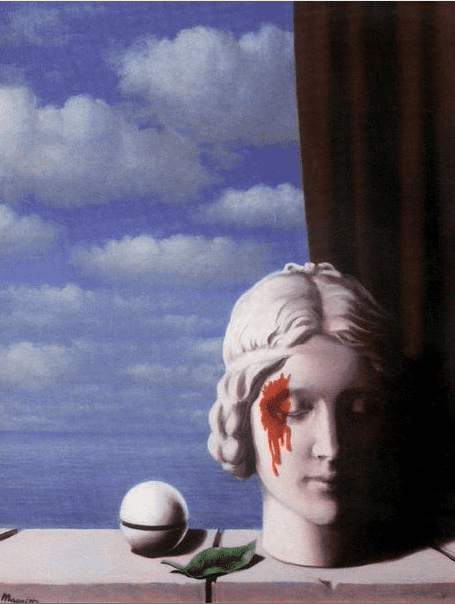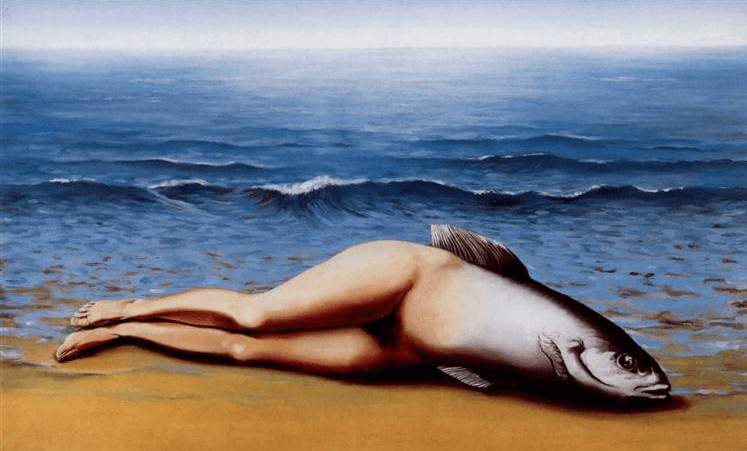Mirjana Stojkovic-Ivkovic
Belgrade, Serbia

A painter’s creativity often results from artistic inspiration, but it can also be a manifestation of fear, pain, and suffering. René Magritte (1898–1967), a Belgian painter and great figure in modern art, expressed his thoughts and his feelings on the canvas. His unique style and original ideas make him one of the most recognized painters in the world.
René began to paint when he was twelve years old. At fourteen, his mother made a series of suicide attempts and finally succeeded by jumping in the river. René was there when they drew her body out of the river, her face wrapped in a nightgown. That incident and other traumas related to his mother’s illness greatly influenced his work.

In order to understand Magritte’s unconscious impulses and their effect on his creativity, it is necessary to analyze his childhood, the damage he suffered, his behavior, and his creative material. Some psychoanalysts claim that traumatic experiences in childhood represent a decisive moment in the emergence of genius.1 Magritte’s childhood was marked by instability, relocation, financial problems caused by his father’s bad investments, and his mother’s dramatic death.2
No matter what kind of traumatic experience a child suffers, it will follow him like a ghost, influencing every part of his life. Each reminder causes a bodily reaction. But if a painter is able to express his trauma and feelings on the canvas, he can more easily deal with the consequences of the traumatic experience. Many believe Magritte’s inspiration for his works Lovers and The Main Story was his witness of his mother being pulled from the river. Psychoanalyst Marthe Woltenstein thinks that this experience created contradictory feelings in Magritte: to see or not to see, to love or not to love, to be afraid or not to be afraid. Many of the women in his paintings seem to be half-alive or half-dead.

There was an unequal relationship between his parents. His father was despotic and dominating. A child unwillingly enters into parental conflicts, and this creates feelings of ambivalence. Art allows a child to reclaim a sense of power. Magritte was able to create or destroy through his use of illusion in his art. Playing with reality allowed him to move between the wish that his mother was alive and the knowledge that she was dead.3
Magritte’s paintings provoke feelings of anxiety. He often repeated the same motifs but in different surroundings. He believed that our perception of the world around us is no more than our internal vision of our own experience.4 He also reflected on serious problems of society through his art, including the role of women. The painting Memory shows a bust of a woman’s head with a red spot on her temple.
Not all conflicts have a pathological origin and even mentally healthy people have conflicts. But some people who suffer serious conflicts in childhood react with behavior that is rigid, stereotypical, and repetitive. This behavior is a way to release negative emotions.5 When an artist paints, he also releases the negative emotions of internal conflicts through repetitive actions. He can transform neurotic tendencies through sublimation in his art.
Interpreting Magritte’s art through the lens of his lived experience does not underestimate the significance and value of his opus, but rather incorporates the effect of trauma and its influence on his creativity.
References
- V.J. Psychoanalysis and culture, ARS Libri, Zemun, 2006. 211, 212.
- V.J. Illness and creating, Neven 2006. 25.
- B.I. Collins, JR 1990. 185.
- H.H. Arnason 2009. 308.
- V.J. Psychoanalysis and Culture, ARS Libri 2006. 219, 223.
MIRJANA STOJKOVIC-IVKOVIC was born in Vranje, Serbia and received her medical degree in Niš. She specialized in psychiatry and works at the Institute for Healthcare of Railway Workers of Serbia, Belgrade.
Highlighted Vignette Volume 14, Issue 3 – Summer 2022

Leave a Reply